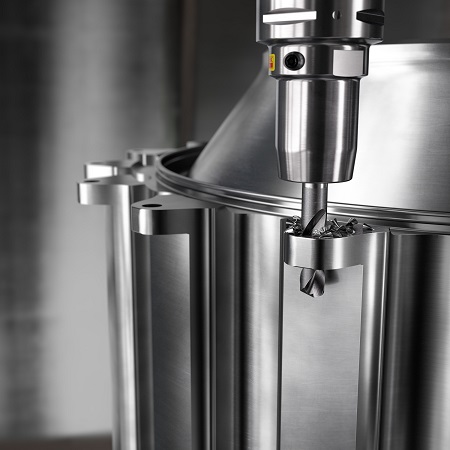"Measure twice and cut once," is a common expression in manufacturing, but it’s easier said than done when machining difficult materials. That’s why, when a leading global manufacturer in aerospace sought to eliminate an entire second stage from its drilling processes, while also improving the hole quality in its aerospace components, it turned to the global leader in metal cutting. Here, James Thorpe, global product manager at Sandvik Coromant, explains how a drill’s design is integral to producing better quality holes.

Hole surface integrity is a real concern for aerospace manufacturers, or general engineering diversifying into aerospace.
Holemaking is the most common of all machining processes, but it is also the one most often taken for granted. Many machine shops see little reason to change or upgrade their existing holemaking setup and have been using the same tools and cutting parameters for years. But, as the unpredictable effects of COVID-19 continue, this is all set to change.
McKinsey & Company’s recent COVID-19: Briefing note calls the present industry situation a “next normal”, where manufacturers can expect unpredictable and lasting shifts in customer markets. The report advises that, “resilience will be needed if manufacturers are to navigate an economically and socially viable path.”
Most manufacturers, for example, are exploring new vendor bases and products. So, machine shops that once specialised in a certain area of production are now opening their CNC lathes and mills to a wider variety of tough and challenging materials. At the same time, manufacturers must explore new ways to increase profits and reduce cycle times, without sacrificing product quality.
In other words, it’s time for manufacturers to rethink how they go about making holes.
The white stuff
Hole surface integrity is a real concern for aerospace manufacturers, or general engineering companies that want to diversify into aerospace. Better hole quality is vital for preventing component failure and is very much determined by the manufacturing processes used for machining or finishing the holes.
Tooling solutions, and cutting edge-geometries in drills, are continually evolving to meet the highest standards of manufacturing and part quality. The use of coolant is also improving for reducing heat build-up in the tool. And tests have found that each of these factors can control the so-called “white layer” effect on workpiece materials.
The term white layer was coined by a leading global manufacturer in aerospace that is also a customer of Sandvik Coromant. It refers to a thin, ultra-fine grain structure that is observed after component drilling, caused by the heat of the drill. Not only can the white layer change the surface properties of the material, it was also deemed unacceptable within the customer’s quality management processes.
The manufacturer applies a strict hole-finishing process to drilled holes in aerospace components, including turbine discs, compressors, drums and shafts. That’s why it chose to partner with Sandvik Coromant to investigate why the white layer forms, and how to control it.
It’s important to note that the tests were not only motivated by quality management. At senior management level, the customer wanted to reduce its overall operational time, and increase profits, and do so by eliminating an entire secondary machining process.
Second act
The secondary process happens after a hole has been created with the carbide drill and can involve reaming, plunge end or milling to finish the component. The secondary stage occurs mainly to meet surface integrity demands — reducing issues like the white layer — rather than dimensional accuracy, with the exception of when machining tight tolerance holes.
From an overall cost perspective, the secondary process is even more expensive than maintaining low cutting data, which is the other way to preserve surface integrity. That is why Sandvik Coromant’s customer wanted to investigate doing away with the process altogether. A supplier with a product that produces a conforming hole to size, without any secondary processes, is in a strong business position to significantly reduce the cost per part.
The investigation into causes, and possible preventions, of the white layer involved four tests of drilling the high-strength, nickel chromium material Inconel 718, a popular aerospace material. It was the first time any such investigation had been carried out by the customer.

With the CoroDrill® 860 with -SM geometry, longer tool life and better hole quality is down to the design of the drill.
The tests assessed drilling with two solid carbide drills by Sandvik Coromant, the CoroDrill R840 and CoroDrill R846. Each was run at two different sets of cutting parameters: 58 mm/min and 98 mm/min, respectively, and spin speed, 829 rev/min and 757 rev/min, respectively. Cutting force and torque data were measured throughout the tests, as was the white layer thickness.
Since these tests, R840 has been superseded by the CoroDrill® 860 with -GM geometry and R846 has been superseded by the CoroDrill® 860 with -SM geometry. Each of these next generation tools is designed to further enhance the tool life, without compromising hole quality.
The results gave some valuable insights into what causes white layer thickness. Particularly of note was that the R846 generated less white layer, due to the preparation of its curved and radial-cutting edges. Meanwhile, the straight cutting edges and chamfer imposed on the cutting edge of the R840 are believed to be linked with the increase in cutting force, torque and white layer thickness. So, the drill’s design determines whether high hole quality, with a reduced white layer, can be achieved without sacrificing cutting data.
Not only did the global aerospace manufacturer’s tests with Sandvik Coromant reveal a thing or two about the white layer, the company has also been able to eliminate some secondary processes, like reaming and plunge milling, which has resulted in time and cost benefits. What’s more, the results have also validated the design of Sandvik Coromant’s CoroDrill® 860 range of carbide drills.
Better by design
The range includes the aforementioned CoroDrill 860 with -GM (CD860-GM) geometry, designed to be a good all-rounder for drilling challenging ISO P, M, K and H materials across all industry sectors. Also, the CoroDrill 860 with -SM geometry (CD860-SM), for machining ISO-S grades like super alloys (HRSAs), titanium and Inconel. The latter drill has proven especially popular in aerospace.
With the CD860-GM and CD860-SM, Sandvik Coromant’s engineers applied the ethos that longer tool life and better hole quality is down to the design of the drill. The CD860-GM has an innovative polished flute design that improves the evacuation of chips, and yields high core strength and reduced cutting forces while drilling.
The CD860-SM, meanwhile, has a new grade and optimised and refined point geometry, which further enhances tool life when working with difficult-to-machine HRSA materials. The result is greater hole quality.
The CoroDrill 860 has already been proven in pre-market tests in a range of sectors. A mechanical engineering company in France put the CD860-GM to work on AISI 4140 structural steel. It was able to achieve quality holemaking with both a concave and convex entry of the drill, with good straightness and tolerance. The company has since formed a new business relationship with Sandvik Coromant.
Another Sandvik Coromant customer, an Italian general engineering manufacturer, achieved a more than 45% productivity increase using the CD860-GM when machining the strong, steel alloy 34CrNiMo6, versus use of a competitor’s drill. It also achieved a 100% greater tool life. Elsewhere, the CD860-SM has yielded impressive results in the machining of Inconel 718. In particular, testing undertaken in Katowice, Poland, was able to achieve a 180% improved tool life with the CD860-SM versus the use of the CoroDrill R840.
Whatever the sector — whether it’s aerospace, general engineering or other areas — high tool performance can be achieved if the drill is designed properly for that purpose. Meanwhile, additional online tools like Sandvik Coromant’s CoroPlus® Tool Guide can provide further support. By accessing the tool via a web browser and entering the desired workpiece material, hole diameter and depth, users can find the best solid round tool and cutting data for their requirements.
While “measure twice and cut once” drilling hasn’t been achieved yet, the performance of the CD860-GM and CD860-SM help manufacturers rethink how they make holes.














